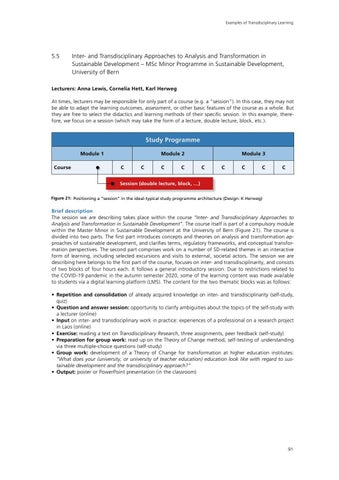Examples of Transdisciplinary Learning
5.5 Inter- and Transdisciplinary Approaches to Analysis and Transformation in
Sustainable Development – MSc Minor Programme in Sustainable Development, University of Bern Lecturers: Anna Lewis, Cornelia Hett, Karl Herweg At times, lecturers may be responsible for only part of a course (e.g. a “session”). In this case, they may not be able to adapt the learning outcomes, assessment, or other basic features of the course as a whole. But they are free to select the didactics and learning methods of their specific session. In this example, therefore, we focus on a session (which may take the form of a lecture, double lecture, block, etc.).
Study Programme Module 1 Course
Module 2 C
C
C
C
Module 3 C
C
C
C
C
Session (double lecture, block, …) Figure Figure 21: 1: Positioning a “session” in the ideal-typical study programme architecture (Design: K Herweg)
Brief description The session we are describing takes place within the course “Inter- and Transdisciplinary Approaches to Analysis and Transformation in Sustainable Development”. The course itself is part of a compulsory module within the Master Minor in Sustainable Development at the University of Bern (Figure 21). The course is divided into two parts. The first part introduces concepts and theories on analysis and transformation approaches of sustainable development, and clarifies terms, regulatory frameworks, and conceptual transformation perspectives. The second part comprises work on a number of SD-related themes in an interactive form of learning, including selected excursions and visits to external, societal actors. The session we are describing here belongs to the first part of the course, focuses on inter- and transdisciplinarity, and consists of two blocks of four hours each. It follows a general introductory session. Due to restrictions related to the COVID-19 pandemic in the autumn semester 2020, some of the learning content was made available to students via a digital learning platform (LMS). The content for the two thematic blocks was as follows: • Repetition and consolidation of already acquired knowledge on inter- and transdisciplinarity (self-study, quiz) • Question and answer session: opportunity to clarify ambiguities about the topics of the self-study with a lecturer (online) • Input on inter- and transdisciplinary work in practice: experiences of a professional on a research project in Laos (online) • Exercise: reading a text on Transdisciplinary Research, three assignments, peer feedback (self-study) • Preparation for group work: read up on the Theory of Change method, self-testing of understanding via three multiple-choice questions (self-study) • Group work: development of a Theory of Change for transformation at higher education institutes: “What does your (university, or university of teacher education) education look like with regard to sustainable development and the transdisciplinary approach?” • Output: poster or PowerPoint presentation (in the classroom)
91














